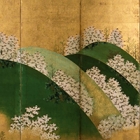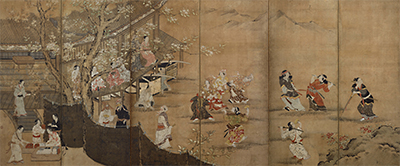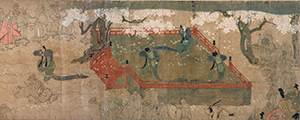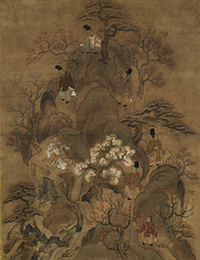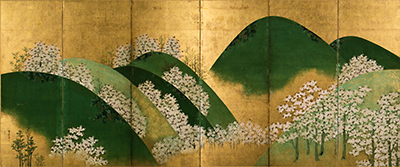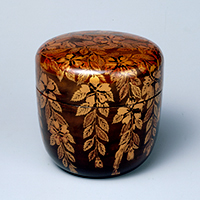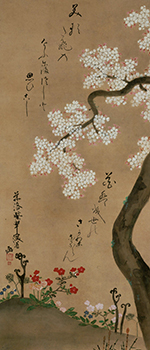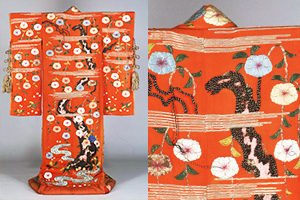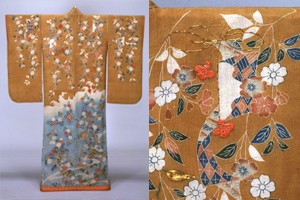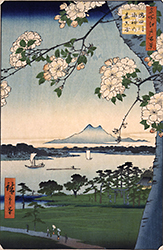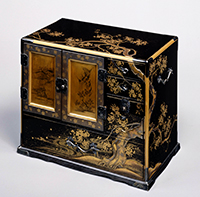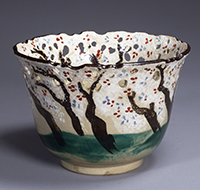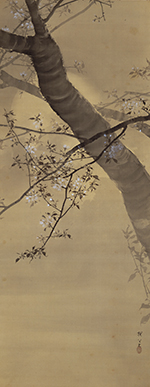National Treasure Gallery
Merrymaking Under Blossom Trees (left hand screen)
By Kano Naganobu, Edo period, 17th century (National Treasure)
Room 2, March 17 - April 12, 2015
This pair of screens depicts a scene of cherry-blossom viewing. The left-hand screen features a young nobleman watching colorfully dressed men and women dancing from the veranda of a temple.
Buddhist Art: Heian - Muromachi period
Tengu zoshi emaki (Stories about conceited monks), Toji and Daigoji Version (detail)
Kamakura period, 13th century (Important Cultural Property)
Room 3, February 24 - April 5, 2015
This illustrated scroll criticizes the arrogance of Buddhist monks at the time by using long-nosed tengu goblins as metaphors.
Courtly Art: Heian - Muromachi period
Parody of Aging as a walk on Oinosaka Slope (detail)
Artist unkown, Kamakura period, 14th century
Room 3, February 24 - April 5, 2015
This painting compares human life to the climbing of a mountain.
So what is a human lifetime? This thought-provoking work gives each viewer something to ponder.
Folding Screens and Sliding Door Paintings: Azuchi-Momoyama - Edo period
Mount Yoshino (left hand screen)
By Watanabe Shiko, Edo period, 18th century (Private collection)
Room 7, March 10 - April 19, 2015
The Arts of Daily Life: Azuchi-Momoyama - Edo period
Tea Caddy, Drooping cherry design in maki-e lacquer
Edo period, 17th century (Gift of Mr. Hirota Matsushige)
Room 8, February 24 - April 19, 2015
This is a representative example of tea caddies known as Saga natsume, which were made by anonymous craftsmen in Kyoto during the Momoyama and early Edo periods. The designs covering the surface are skillfully rendered, and without being confined to detail they present a relaxed style.
Developments in Painting and Calligraphy: Azuchi-Momoyama - Edo period
Cherry Tree and Spring Plants
By Ogata Kenzan, Edo period, 18th century (Gift of Mrs. Yamamoto Tomiko and Mr. Yamamoto Kenji)
Room 8, March 10 - April 19, 2015
Noh and Kabuki
Furisode (Garment with long sleeves), Cherry blossom and stream design on red chirimen crepe ground
Formerly used by Bando Mitsue, Edo period, 19th century (Gift of Ms. Takagi Kiyo)
Room 9, March 17 - May 17, 2015
This costume is believed to have been used for the role of Yaegakihime in the drama "Honcho Nijushiko".
The embroidered or appliquéd designs are padded with cotton to create three-dimensional and ornamental effects.
Ukiyo-e and Fashion in the Edo Period: Fashion
Furisode (Garment with long Sleeves), Weeping cherry, chrysanthemum, and tanzaku paperdesign on light-blue and brown crepe
Edo period, 18th century
Room 10, March 17 - May 17, 2015
Designed to be worn during two seasons, this furisode garment features a spring pattern from the hips up, and an autumn pattern from the hips down. This split-pattern style was popular from the mid to late Edo period, when women enjoyed tying their sashes with a variety of knots – providing a wide area that clearly separated the two designs.
Ukiyo-e and Fashion in the Edo Period: Ukiyo-e
One Hundred Famous Places of Edo: Suijin Shrine and Massaki by Sumida River
By Utagawa Hiroshige, Edo period, dated 1856
Room 10, March 17 - April 12, 2015
Lacquerware
Cabinet, Mount Yoshino design in maki-e lacquer
By Kajikawa, Edo period-Meiji era, 19th century
Room 12, February 10 - May 6, 2015
Ceramics
Bowl, Cherry tree design in openwork and overglaze enamel
By Nin'nami Dohachi, Edo period, 19th century
Room 13, March 17 - May 10, 2015
Modern Art
Cherry Blossom Under Misty Moon
By Konoshima Okoku, Showa era, 20th century (Gift of Mrs. Nagai Yoshiko)
Room 18, March 17 - April 19, 2015

